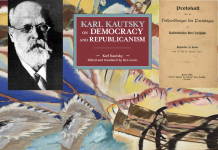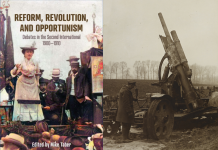
In the concluding part of our serialisation of his 1978 essay on the state in capitalist society, Colin Barker considers the theory of the Permanent Arms Economy. Originally developed by Mike Kidron, the theory posited that arms production and expenditure by states was responsible for the relative stability and growth of capitalism in the post-war era.
Barker questions this theory by building on the arguments developed the first two parts of his essay: namely, on the role of the state within the capitalist process, and the status of luxury production in relation to other parts of the capitalist economy.
His conclusions help to redefine the way we think about state power in capitalist society, and laid the foundations for his latter writings on state power that we shall be publishing in Revolutionary Reflections.
Parts one and two can be found here and here.
Looking again at our traditions
Everything we have said so far has been intended to support the proposition in Mike Kidron’s Western Capitalism Since The War, that the development of state ‘intervention’ could not, in and of itself, account for the existence of the long boom of the post-war decades. State intervention may have the effect of displacing the manner of manifestation of crisis from one form to another, but it cannot in itself explain general tendencies of capitalist development, cannot explain either boom or crisis. The partial, national form of the state in capitalism only emphasises this limitation on the possibilities for state intervention.
That said, I want rather cautiously to suggest that some parts of the general argument we have inherited from the International Socialist (IS) tradition of analysis need to be looked at again. In particular, I want to raise two questions, one about ‘finance capital’, and the other about luxury spending and its impact on capitalist development. In both cases the starting-point of my queries is work by Kidron, not because I want to develop an ‘Anti-Kidron’, but because Kidron was the only IS comrade, in reality, who made any significant contribution to our understanding of the movement of capital, after the replacement of the journal Socialist Review with International Socialism. To probe our own theoretical heritage is of necessity to probe Mike Kidron’s publications.
I’ll deal with the two questions separately, though this very separation is a confession on my part of an inability to provide answers.
‘Finance Capital’
In an article originally published in International Socialism, Mike Kidron offered a critical review of the applicability of Lenin’s Imperialism, the Highest Stage of Capitalism to the comprehension of contemporary capitalism.1 I want to focus on just part of the article, where Kidron discusses Lenin’s account of ‘finance capital’. Lenin had stressed that a crucial feature of imperialism, as the ‘highest stage of capitalism’, was the dominance over industrial capital of the capital concentrated in the hands of the banks and other financial institutions, Lenin suggested that so great was finance capital’s power that,
… in all economic and international relations… it is capable of subordinating to itself, and actually does subordinate to itself, even states enjoying complete political dependence.
Kidron comments:
These are large statements and quite a lot of time could be spent on examining whether they were entirely justified even fifty years ago. Whatever the case, they carry little conviction today as descriptions of the central institutional relationships within capitalist society.
And he then sets out to show that industrial firms are no longer (if they ever were) dependent on the banks, etc. Rather they are net lenders to the rest of the industrial economy. In any case, the banks are on the whole unwilling controllers of industrial assets, etc. The institutional relations of contemporary capital in the post-war period do not conform to Lenin’s picture. A few comments seem to be appropriate.
First, in the terms in which Kidron (and Lenin) posed the question, Kidron still seems to be correct in important respects even today. Despite the fact that more than half the industrial equity capital quoted on the London Stock Exchange is now in the hands of the various ‘financial institutions’ (banks, insurance companies, pension funds, unit trusts), these still tend to hold to a self-denying ordinance as far as direct control of industrial policy and assets is concerned. Each institution separately tries to keep down the level of its holding in any particular industrial concern, so as not to get ‘too committed’.
Second, the validity of Kidron’s picture seems, on the other hand, not to have been entirely supported by developments since he wrote his article. This is part of the burden of Nigel Harris’s recent sketch of developments in contemporary world capitalism, in whose opening paragraph Harris refers to ‘the reappearance of what Lenin and Hilferding called “finance capital” – the growing centralisation of international economic power in the hands of the Western banks’. Harris presents some important data on the growth of debt and loan credits, though he restricts his discussion largely to the ‘less developed countries’.2
Third, Kidron’s account of the institutional relations is a bit one-sided especially in a writer who has stressed elsewhere the importance of state-sponsored production. He leaves out of his discussion of ‘industrial firms’ the nationalised industries. Had he included them, he might well have modified his conclusions as to the institutional relations between productive capitals and financial institutions, for throughout the post-war period the banks appear to have been willing lenders to Western capitalist governments, who have resorted to the credit market to socialise the ‘losses’ and finance the massive investments of their own industries.
Fourth, and perhaps most important, Lenin’s own account of ‘finance capital’ was treated rather uncritically. This is as true of Kidron’s critics (e.g. Tom Kemp) as it was of Kidron himself. In a sense, both Lenin’s defenders and his critics have focused attention on the questions to which Lenin directed himself: namely, the institutional relations between industrial firms and finance houses. None of them appears to have attempted what Lenin certainly did not attempt, which is to try to relate the institutional discussion to the categories of Marx’s Capital, in particular to Marx’s discussions of the different forms of money and above all of credit.3 In a way, the whole debate about ‘finance capital’ has focused on the wrong question. The discussion has centred on the institutional relations between different institutional forms of capital, and not on the functional forms of capital.
It seems clear that credit has been expanding faster than capitalist production for a long time. In terms of the characterisation of the system, the fact that credit-money itself appears to have become increasingly dominant is of perhaps greater long-term significance than the question as to which institutions have been the ‘lenders’ and which the ‘borrowers’. Cautiously (for I can’t take the argument very far at present) I suggest that general credit expansion underpins the general inflationary tendency apparent in the world capitalist economy throughout the century.
Certainly, we’ve generally failed, up to now, to provide anything very significant by way of an analysis of the politically critical question of inflation. We’ve tended to restrict ourselves to a few quick points to show that inflation is not the workers’ fault (or, worse, not ‘entirely’ the workers’ fault), effectively copping out of the question. It’s doubtful that we can duck the question much longer. Without being able to offer a worked out theoretical account, it does seem to me that the massive expansion of credit, allied to the growth of state capital (and state debt), must play a significant part in any general historical-cum-theoretical account of world inflation. It is not simply inflation that requires explanation, either, but its combination with the effects of arms spending post-war, and the peculiar ‘stagflationary’ form of the present world crisis.
Arms and luxuries
The second general point concerns the place of production and in particular arms spending in the overall movement of capital. Our tendency has argued – with some uncertainty as to the precise grounds on which we were arguing, whether as Marxists or Keynesians or Sraffians – that the high level of post-war arms spending was, at a minimum, ‘of considerable significance’ in determining the form and length of the world boom, and at a maximum the key explanatory factor behind the boom itself. We tended in general to rely on rather imprecise terms like ‘floors’ and ‘leaks’, and on arguments of the form, ‘Well, we were the only tendency that refused to predict slump, and we were right’ or ‘Well, obviously, arms spending had a bearing on the boom’ – propositions undeniably anchored in reality, though quite how they were anchored we were less than sure.
I’ve already suggested that Kidron’s suggestion, in his essay on ‘Waste’, that luxury production is a form of unproductive labour is wrong, and that the question of the part played by ‘luxury’ production needs to be considered separately from the question of productive and unproductive labour. I now want to raise some questions directly about the role imputed to the ‘permanent arms economy’, by considering the relation between ‘luxury’ (arms) spending and capital as a whole.
In the chapter of Western Capitalism Since the War where Kidron directly argues the ‘arms economy’ thesis, and explicitly seeks in the general level of world arms spending the explanation of the post-war boom, he suggests that it has been ‘proved’ by Sraffa and von Bortkiewicz that luxury production has no effect on the rate of profit. That proposition seems to me untenable. If we look closely at the question, I suggest, we’ll find that changes in production in ‘Department III’ of the economy – the production of ‘luxuries’ – can have significant effects on the general rate of profit.
It is characteristic of Department III that its output does not enter into the means of consumption of the working class, nor into the means of production of the capitalists. It is, from the viewpoint of capital as a whole, a form of production whose output is unproductively consumed, for the consumption of its output does not take the form of a recombination of constant and variable capital in the capitalist labour process. In that sense, to use Kidron’s term, luxury production is ‘waste’ production, is a ‘leak’. The output of the luxury-producing industries does not reappear in the circuit of productive capital, but disappears as effectively as if it had been set on fire.
However, the production process in the luxuries industries is affected, like that in Departments I and II, by the general development of the capitalist productive forces. Here, as elsewhere, the value of labour-power tends to fall as the labour-time embodied in the working class’s means of consumption tends to be reduced. Here, as elsewhere, the productivity of labour tends to rise with advances in capitalist mechanisation. Here, as elsewhere, (and contrary to Kidron’s ‘Waste’ argument) surplus value is produced and enters the collective fund of capital, from which it is removed again in proportion to the relative size of the capitals invested in Department III.
Given the particular character of the luxury goods industries, a rise in the productivity of labour in these industries will not have the effect of helping with the devalorisation of labour-power. For, by definition, the output of these industries does not enter into the consumption of the owners of labour power. Thus a rise in productivity in the luxury industries does not have any influence on the rate of surplus-value in other industries. Nor, therefore, does it have any effect on the rate of profit insofar as this is determined by the rate of surplus value.4
Nor does rising productivity in the luxury industries have the effect of cheapening the elements of constant capital, for, again by definition, the luxury industries do not produce raw materials, machinery, etc., for productive consumption by capital. Here again, rising productivity in the luxury industries does not have any effect on the rate of profit, insofar as this is determined by the value of constant capital.
Rising productivity in the luxury industries does have an effect on the amount of surplus-value produced. The amount of surplus-value produced is determined by (a) the rate of surplus-value and (b) the number of workers simultaneously employed. Other things being equal, to the degree that rising productivity in the luxury industries diminishes the number of workers employed by a given quantity of capital, it reduces the amount of surplus-value produced. The same result obtains if the organic composition of capital in this sector rises while the number of workers remains the same. Since the rate of profit in the luxuries sphere enters into the equalisation of the rate of profit then, all other things being equal, the rate of profit will fall if the productivity of the luxuries industries rises.5 (NB: this argument is not peculiar to the luxuries industries, of course.)
The luxuries industries are not immune to the general tendencies of capital, the tendency for the organic composition of capital to rise and thus for the rate of profit to fall. But, because their increased productivity does not reduce the value of labour power or of constant capital, the luxuries industries are a drag on those elements in the capitalist reproduction process which tend to counteract the tendency for the rate of profit to fall. In this sense, the greater the total proportion of capital devoted to luxury production, the less strong are the tendencies to slow down or counteract the tendency for the rate of profit to fall. On the other hand, the investment of capital in luxury production also slows down the re-investment of surplus-value as capital in the other two Departments, and thus slows down the effects of the rising organic composition of capital by slowing down the growth of constant capital in Departments I and II.6
The effects of luxury production, and of alterations in the relative weight of luxuries production in the whole capitalist economy, as well as of rising productivity in the luxuries sector, are thus not without significance for the general rate of profit. But those effects are contradictory. It is simply not satisfactory, however, to treat contradictory effects as necessarily balanced, i.e. to assume that luxury production has no effect on the general rate of profit.
The general effect of expanded luxury production is not to promote capitalist expansion, but to promote capitalist stagnation. For the expansion of the luxuries sector demands the diversion of a part of value into capital devoted to the production of commodities which do not re-enter the capitalist process of reproduction as useful inputs but are unproductively consumed (‘leaked’, ‘wasted’). Luxury spending holds back the growth of capital. However, to the degree that it holds back the growth of capital, it holds back the tendency of the organic composition of capital to rise, and thus of the rate of profit to fall. Thus it acts as a damper on the crisis-tendencies of capital, insofar as these are the result of the falling rate of profit.
The logic of this argument appears to be, though, that the expansion of arms production cannot explain the post-war boom. It can help explain the form of the boom, and perhaps the relative length of the boom. It can also, perhaps, help to explain the form of the crisis and also the relative length of the crisis. Arms spending explains, perhaps, the smoothness of the boom, and the illusions therefore in ‘planned capitalism’ which the boom promoted, as perhaps it can explain partly the stagflationary form of the crisis. That is, arms spending might help explain the sluggishness of the boom, and the sluggishness of the recession, but not the boom or the recession themselves. (To return to the earlier point about ‘finance capital’, the states’ financing of their massive arms purchases generally induced inflationary expansions of credit, and there is an intimate inter-relation, required to be worked out in detail, between the expansion of arms production and its stagflationary effects, and the inflationary role of credit expansion.)
If, as I hesitantly suggest, the ‘permanent arms economy’ cannot in fact explain the boom in the sense, as Chris Harman puts it, that it cannot explain the ‘extent’ of the boom in the 1950s and 1960s, but can only explain some aspects of the form of the boom – its slowness of movement, its initially gently inflationary form, the small scale of the recessions of the 1950s and 1960s – then we have to admit we are left without an adequate account of the basis of post-war capitalist economic development. And, surely, it must be said that Kidron has not, in recently dismissing the arms economy thesis, provided an alternative, for his suggestions are vague in the extreme:
It is hard to sustain the view that it was the permanent arms economy that fuelled the boom. On the contrary, such expenditure must have worked towards stagnation. And if in reality heavy spending on arms coincided with an unprecedented expansion of capital, it can only be because the effects of arms spending were overpowered by the effects of something much more fundamental – the changes that attended the consolidation of the state capitalist system; changes that redirected vast working populations from barely productive work in agriculture towards higher productive occupations in industry; changes that reduced the amount of social capital required for the new workers and so sharply lightened the capital structure throughout the world; changes that increased the technical division of labour sharply and reduced duplication of effort as capitals themselves grew to national proportions. On this reading, it was despite the arms economy, not because of it, that the first years of state capitalism were years of release of’ the productive forces and of expansion.7
What Kidron is describing here are the manifestations of the boom. In no way is it clear how these ‘early years of the state capitalist system’ (even allowing that dubious characterisation) should produce the result. This is especially the case regarding the centralisation of capital by the nation-state, which mostly develops as a response to crisis, rather than itself being a source of capitalist growth.
Chris Harman is right to feel uneasy about the situation this leaves us in – dependent, as he puts it, on ‘those like Ernest Mandel who argue that the 25-year boom after the war was an accident of history’, dependent on ‘empiricist reformism’. I can’t solve Chris’s feeling of unease. I think, the only solution is for us to work over the historical and theoretical materials and solve the problems adequately. We’ve already delayed too long over the problem of accounting for the changes in world capitalism, and the sooner we start the better for our politics. We ought not to rely, as we tended to, on rather vaguely formulated notions and concepts whose origin and inter-relation were rather dubious. Some of our theoretical baggage needs sorting through, and some needs chucking out. It gave us, perhaps more fortuitously than we knew, a not bad orientation for a whole period. Today, however, we need (shifting metaphors!) to recalibrate our compass quite urgently. We might usefully do this rather more collectively than we did in the past, when a few theoretical ‘stars’ were thought all we needed to steer by.
Footnotes
1 Michael Kidron, ’Imperialism, highest stage but one’, International Socialism, 1st series, 9 (1962), reprinted in: Michael Kidron, Capitalism and Theory (London: Pluto, 1974).
2 Nigel Harris, ‘World crisis and the system’, International Socialism, 1st series, 100 (1977), 27-35.
3 On this general point, see: Athar Hussein, ’Hilferding’s Finance Capital’, Bulletin of the Conference of Socialist Economists, 15 (1976).
4 This argument is clearly presented in: Karl Marx, Theories of Surplus Value (London: Lawrence & Wishart, 1972), III, p. 349.
5 Marx, Theories of Surplus Value, III, p. 350.
6 Chris Harman’s formulation of the luxury industries question is generally closer to the case I am arguing here, with one small exception. In his: ‘Better a valid insight than a wrong theory’, International Socialism, 1st series, 100 (1977) (p. 11), Harman outlines a correct approach to the question, but adds a slip:
…the workers and capitalists in the arms sector bring their claims onto the market for a share of the goods produced in the other, productive sectors of the economy – consumer goods, new plant and equipment, etc. It is in this sense that capital in the arms industry is unproductive – it does not add to the total number of commodities embodying value and surplus-value on the market. Like commodity- and money-capital it represents a claim on the total surplus-value produced elsewhere.
Earlier in the same paragraph, Harman argues that ‘workers in these industries produce commodities; they create value and surplus-value’. He simply contradicts himself. The simple, and correct, solution to his self-contradiction is to abandon the second proposition. The arms industry is not unproductive. The form of consumption of its output is unproductive but that is not the same thing at all. Its claim to surplus-value is of the same kind as that made by every other productive capital: it has contributed to the collective pool of value, and demands back a share proportional to its size. That the value produced in the arms industry, or any other luxury industry, is consumed unproductively by the capitalist class is – from the standpoint of this particular question – neither here nor there.
Also disputable is Harman’s footnote on the question of the effects of the arms economy, which concludes
… the rate of profit in the arms industry is determined largely by government contracts on a cost-plus basis, rather than through the inflow and outflow of capital, so that the fact that capital in the arms sector has a higher than average composition does not bring down the general rate of profit. (‘Better a valid insight…’, 13)
Such a conclusion involves the very dubious assumption that the state’s transfer of ‘cost-plus’ profits to arms producing capitals is not part of the ‘inflow and outflow of capital’, given that the state must get the money from somewhere. If the state, effectively, prints the money, the effects will be generally inflationary, with consequent depressing results on the rest of capital’s profits (cf. the whole debate about inflation-accounting and profits, which is very serious for capital). The conclusion must be that the profits of the arms sector are not capable of being isolated from the movement of capital overall, and thus that the ‘higher than average composition’ of capital in the arms sector – assuming its exists – will tend to ‘bring down the general rate of profit’. For the implication of a higher than average composition of capital in a particular branch of industry is that the rate of profit in that branch is lower than average, and its claims to average profitability (and worse, if the state is guaranteeing its profits) must involve a reduction in the rate of profit elsewhere.
7 Michael Kidron, ‘Two insights don’t make a theory’, International Socialism, 1st series, 100 (1977), 9.
Bibliography
Elmar Altvater, ‘Notes on state interventionism’, Kapitalistate, 1 (1973), 96-10; 2 (1973), 76-83.
Chris Arthur, ‘Toward a materialist theory of law’, Critique, 7 (1977), 31-46.
Isaac Balbus, ‘Ruling-class elite theory vs. Marxian class analysis’, Monthly Review, 23:1 (1971), 36-46.
Paul Baran, The Political Economy of Growth (Harmondsworth: Penguin, 1957).
Colin Barker, ‘A note on the theory of capitalist states’, Capital and Class, 2:1 (1978), 118-26.
Harry Braverman, Labor and Monopoly Capital (New York: Monthly Review Press, 1974).
Nikolai Bukharin, Imperialism and World Economy (London: Merlin, 1972).
Paul Bullock, ‘Categories of labour power for capital’, Bulletin of the Conference of Socialist Economists (Autumn 1973), 82-98.
Paul Bullock, ‘Defining productive labour for capital’, Bulletin of the Conference of Socialist Economists (Autumn 1974).
Paul Bullock and David Yaffe, ‘Inflation, the crisis and the postwar boom’, Revolutionary Communist, 3:4 (1975), 5-45.
Tony Cliff, Russia: A Marxist Analysis (London: Pluto, 1970).
Rosemary Crompton and Jon Gubbay, Economy and Class Structure (London: Macmillan, 1977).
Friedrich Engels, Anti-Dühring (Moscow: Progress, 1959).
Friedrich Engels, The Origin of the Family, Private Property and the State, in: Karl Marx and Friedrich Engels, Selected Works (London: Lawrence & Wishart, 1968).
Ann Foreman, Femininity as Alienation (London: Pluto, 1977).
John Kenneth Galbraith, The New Industrial State (Harmondsworth: Penguin, 1968).
Jock Bruce-Gardyne, Whatever Happened to the Quiet Revolution? (London: Charles Knight, 1975).
Chris Harman, Bureaucracy and Revolution in Eastern Europe (London: Pluto, 1974).
Chris Harman, ‘Marxist economics and the world today’, International Socialism, 1st series, 76 (1975), 29-32 & 34-6.
Chris Harman, ‘Better a valid insight than a wrong theory’, International Socialism, 1st series, 100 (1977), 9-13.
Nigel Harris, Competition and the Corporate Society (London: Methuen, 1972).
Nigel Harris, ‘World crisis and the system’, International Socialism, 1st series, 100 (1977), 27-35.
Sue Himmelweit and Simon Mohun, ‘Domestic labour and capital’, Cambridge Journal of Economics, 1:1 (1977), 15-31.
John Holloway and Sol Picciotto (eds), State and Capital: A Marxist Debate (London: Edward Arnold, 1978).
Jane Humphries, ‘Class struggle and the persistence of the working class family’, Cambridge Journal of Economics, 1:3 (1977), 241-58.
Athar Hussein, ‘Hilferding’s Finance Capital’, Bulletin of the Conference of Socialist Economists, 15 (1976).
Eugene Kamenka and Alice Kamenka, ‘The life and after-life of a Bolshevik jurist’, Problems of Communism (January 1970), 72-8.
Michael Kidron, Western Capitalism Since the War (Harmondsworth: Penguin, 1970).
Michael Kidron, Capitalism and Theory (London: Pluto, 1975).
Michael Kidron, ‘Two insights don’t make a theory’, International Socialism, 1st series, 100 (1977).
James C. Kincaid, Poverty and Equality in Britain (Harmondsworth: Penguin, 1973).
David Lockwood, The Blackcoated Worker (London: Allen and Unwin, 1958).
Frank McFadzean, Galbraith and the Planners (Glasgow: University of Strathclyde, 1968).
Ernest Mandel, The Formation of the Economic Thought of Karl Marx (London: NLB, 1971).
Ernest Mandel, Late Capitalism (London: NLB, 1975).
Karl Marx, The Revolutions of 1848 (Harmondsworth: Penguin, 1973).
Karl Marx, Grundrisse (Harmondsworth: Penguin, 1973).
Karl Marx, Early Writings (Harmondsworth: Penguin, 1973).
Karl Marx, Capital, vol. I (Harmondsworth: Penguin, 1976); vol. III (Moscow: Progress, 1963).
Karl Marx, Theories of Surplus Value, vol. III (London: Lawrence & Wishart, 1972).
Ralph Miliband, The State in Capitalist Society (London: Weidenfeld and Nicolson, 1969).
Wolfgang Müller and Christel Neusüss, ‘The illusion of state socialism’, Telos, 2 (1975), 13-90.
Claus Offe, ‘Structural problems of the capitalist state’, German Political Studies, 1 (1974), 31-57.
Evgeny Pashukanis, ‘The general theory of law and Marxism’, in: John N. Hazard (ed.), Soviet Legal Philosophy (Cambridge, MA: Harvard University Press, 1951).
Nicos Poulantzas, Political Power and Social Classes (London: NLB, 1978).
Nicos Poulantzas, Classes in Contemporary Capitalism (London: NLB, 1975).
Nicos Poulantzas, ‘The problem of the capitalist state’, New Left Review, 58 (1969).
Roman Rosdolsky, The Making of Marx’s ‘Capital’ (London: Pluto, 1977).
Martin Shaw, ‘The theory of the state and politics: a central paradox of Marxism’, Economy and Society, 3:4 (1974), 429-50.
Leon Trotsky, In Defence of Marxism (New York: Pioneer, 1942).
Immanuel Wallerstein, The Modern World System (New York: Academic Press, 1974).
David Yaffe, ‘Value and price in Marx’s Capital’, Revolutionary Communist, 1 (1976), 31-49.
Eli Zaretsky, Capitalism, the Family and Personal life (London: Pluto, 1976).



















[…] repeat the many criticisms of TIG’s vacuousness; to catalogue the many ways in which its members (ex-Labour no less than ex-Tory) have enthusiastically supported austerity and toyed with racism when it […]